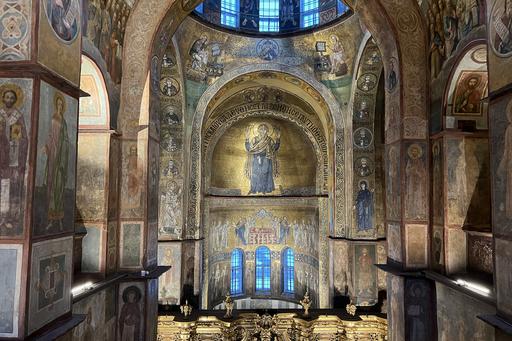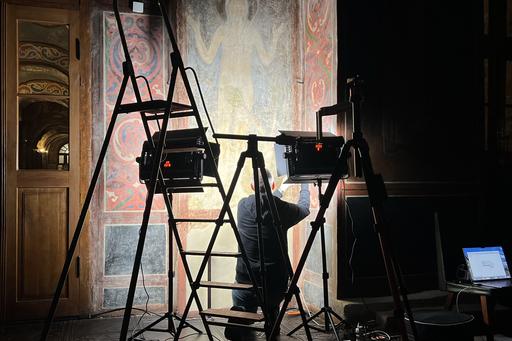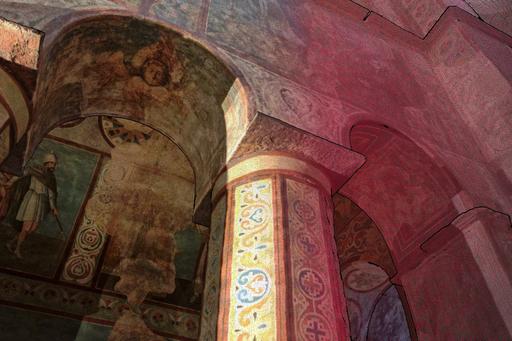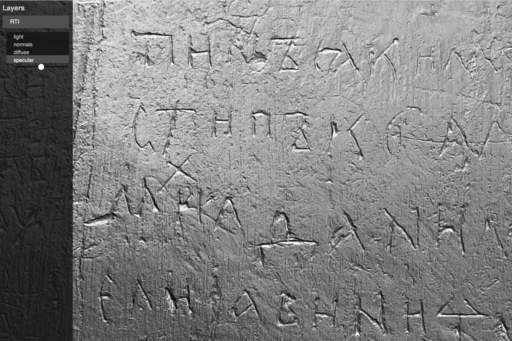
Digital documentation of inscriptions in the Saint Sophia Cathedral in Kyiv
Short description
Carved into the walls of the Saint Sophia Cathedral in Kyiv are more than 7,000 inscriptions that span over a thousand years and follow different language and writing systems. The inscriptions in Saint Sophia Cathedral constitute a source of knowledge about the cultural history of man, language and writing, migration, trade, cultural exchange, and cultural diversity in Europe, and are a primary source for various disciplines and fields of research. It is also a source material that, with Russia's warfare against Ukraine, is under acute threat. To safeguard this cultural heritage and source for future research, a project collaboration between Ukraine and Sweden has been initiated. The project aims to document the inscriptions with diverse digital technologies and publish the data through an online portal.
Background
Since February 2014, Russia has occupied the Ukrainian Crimean Peninsula and on February 24, 2022, Russia invaded Ukraine on a wide front. Russian troops were at the beginning of March 2022 at the Kyiv city border but have now been pushed back to the eastern and southern parts of the country. However, Ukrainian territory is systematically exposed to missiles, artillery and drone attacks, resulting in enormous devastation. The war continues with no peace in sight. It is well documented that civilian targets such as residential areas, hospitals, railways, ports and energy facilities are also bombed.

Against the laws of war, according to the first article of the Hague Convention from 1954, cultural heritage is also destroyed, deliberately and systematically. The ongoing war against Ukraine is a tangible threat to the Saint Sofia Cathedral in Kyiv and the historical inscriptions that also form an important research basis. UNESCO reported on 20 December 2023 that since the start of the war, 334 cultural environments have been damaged, 125 religious buildings and environments, 147 historical buildings, 29 museums, 19 memorials, 13 libraries, and one archive.
In the Kyiv region, a large number of cultural environments and historic buildings have already been destroyed or damaged. Among these we find the State Art Museum, Taras Shevchenko National Museum, Natural History Museum, Academy of Sciences, Taras Shevchenko University, Ivankiv Museum, Khanenko Museum, Borodyanshchyna Local History Museum, Irpin Central Library, Makarivska Library, Pidhaine and Makariv Libraries, Palace of Culture. T. G. Shevchenko, the House of Culture in Petrushkij, the Monastery of the Icon of the Mother of God "Uslyshatelnytsya" in the village of Fasova, the Voznesen'ka Tserkva Church, the Tserkva Heorhiyivsʹka Church in Zavorychi and the Petro-Pavlivska Church.

Research aims
The purpose of the project is to document the inscriptions in Saint Sofia Cathedral using digital techniques. The project secures endangered source material for researchers in Sweden and internationally which is also made available to a wider public.
The goal is to make available detailed 3D models and other digital representations for the highest possible readability of the inscriptions as a basis for research. The digital data that is produced is made available by Gothenburg University's research infrastructure for digital humanities (GRIDH) in a portal with a public and user-friendly interface specially built for reviewing inscriptions.

Theory and method
The inscriptions have attracted previous research interest and around 7000 inscriptions have been identified. Some of the inscriptions have been interpreted and published by Oleksandr Vysotsky (1966, 1976, 1989) and by Vyacheslav Kornienko (2010-20). However, the documentation of the source material has limitations and does not enable other researchers to make independent interpretations. There are uncertainties in how the various cut marks should be interpreted as signs, and how signs should be interpreted as language and meanings. The digital documentation technology that is available today enables high-resolution representation of the primary source material, as a basis for research in different languages and subject areas, but also collaboration between researchers as they can share data about the source material with each other.

The documentation work in Kyiv will be carried out during two fieldwork periods in 2024. During the first fieldwork, a basic documentation of the entire interior will be carried out and different techniques and working methods will be tested and evaluated. Primary techniques are laser, photogrammetry and digital trailing light, so-called Reflectance Transformation Imaging (RTI). Other techniques are also selectively used such as structured light scanning (WLS) and multispectral photography. A working group from Saint Sofia Cathedral is being trained to continue the documentation work.
After the first fieldwork, methods and results are evaluated. Dialogue with researchers with different interests in the source material is gathered to prepare a requirements specification for the database. In the second fieldwork, improved methods and the workflow for the database are implemented. The hope is that the source material will be secured during the project period. The work with the database, which involves the identification and interpretation of previously known and newly discovered inscriptions and meanings, will hopefully continue for many years.
Members
- Gunnar Almevik, Department of Conservation, University of Gothenburg
- Jonathan Westin, Gothenburg Research Infrastructure in Digital Humanities, University of Gothenburg

